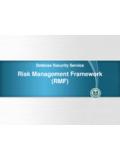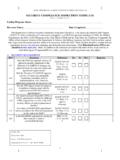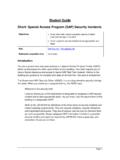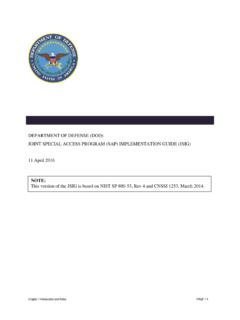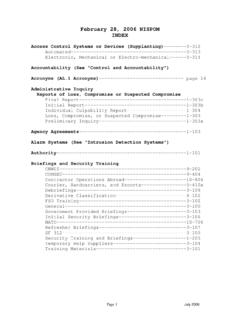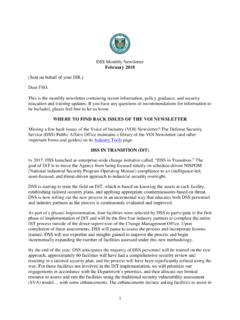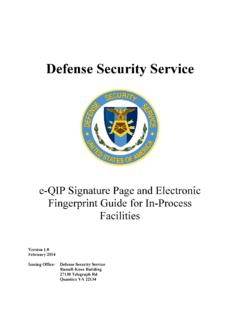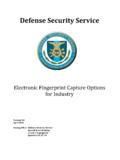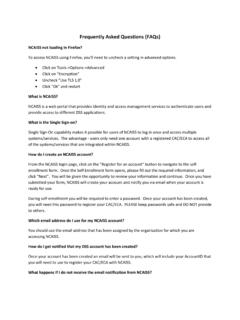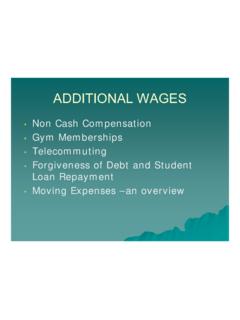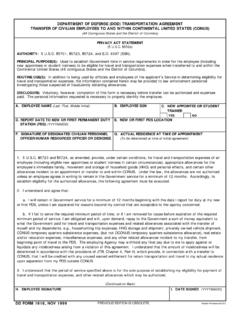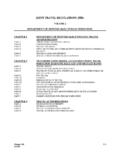Transcription of THE JOINT TRAVEL REGULATIONS - Defense …
1 THE JOINT TRAVELREGULATIONS(JTR)UNIFORMED SERVICE MEMBERSANDDOD CIVILIAN EMPLOYEESMR. DONALD G. SALO, Assistant Secretary of the Army(Military Personnel)REAR ADMIRAL ANDREW S. Coast Guard ReserveActing Director of Reserve and Military PersonnelMS. JULIET M. BEYLERD eputy Assistant Secretary of the Navy (MPP)(Manpower and Reserve Affairs)REAR ADMIRAL DAVID A. SCOREN ational Oceanic and Atmospheric AdministrationDirector, NOAA CorpsMR. JEFFREY R. MAYOD eputy Assistant Secretary of the Air Force(Force Management Integration)REAR ADMIRAL JOAN F. Public Health ServiceDirector, Division of Commissioned Corps Personnel and ReadinessPublished by:The Per Diem, TRAVEL , and Transportation Allowance Department of Defense4800 Mark Center DriveSuite 04J25-01 Alexandria, VA : (571) 372-1301Ch 6: Evacuation TravelTable of Contents08/01/17 TOC 6-1 TABLE OF CONTENTSCHAPTER 6.
2 EVACUATION TRAVEL0601 EVACUATION to Order an an Evacuation Payments for Evacuation Can Terminate Evacuation Allowances0602 ALLOWANCES FOR SERVICE MEMBERS for Evacuation and Transportation during Transportation and Quarantine Evacuation from Foreign While at the Safe Allowances While at Designated when an Evacuation is for Return Dependent Returns to PDS0603 HOUSEHOLD GOODS (HHG) SHIPMENT FOR A SERVICE MEMBER S DEPENDENTS0604 STANDARD ALLOWANCES FOR CIVILIAN EMPLOYEES AND THEIR and Transportation Expense Allowance or Per of HHGCh 6: Evacuation TravelTable of Contents08/01/17 TOC Expense Allowance Rules During Annual Leave, Sick Leave, Home Leave, and Leave Without Pay Evacuation POV Storage Due to an Evacuation Transportation and Quarantine Evacuation from Foreign Expense at the PDS When Home is and Local Transportation CONUS or Non-foreign OCONUS when an Evacuation is Visitation TRAVEL (FVT) during an EvacuationCh 6: Evacuation Travel0601-060409/01/176-1 CHAPTER 6: EVACUATION TRAVELAn evacuation is the authorized or directed departure from an area threatened by unusual or emergency circumstances in the continental United States (CONUS), in a non-foreign location outside the CONUS (OCONUS), or in a foreign location.
3 The information in this chapter complements the Department of State (DoS) Standardized REGULATIONS (DSSR) Chapter 600, Payments During an Ordered/Authorized Departure, and the Office of Personnel Management (OPM) Code of Federal Regulation (CFR), Title Code ( ), Subpart D, Payments During Evacuation . See Table 6-1 to determine which Agency s evacuation policy applies in addition to the JTR. Table 6-1. Identifying which Evacuation Policy to FollowEvacuee Location Being EvacuatedCONUSNon-Foreign Location OCONUSF oreign DoD Service Member s DependentDoDDoDDoD coordinates with DoSNon-DoD Service Member s DependentDoDDoDDoD coordinates with DoSDoD Civilian EmployeeOPMOPMDoSDoD Civilian Employee s DependentOPMOPMDoS0601 EVACUATION AUTHORITYThe authority to evacuate an area depends on whether it is in the CONUS, a non-foreign location OCONUS, or a foreign location.
4 Tables 6-1 through 6-12 identify who can evacuate a location at Government expense and who may authorize an evacuation, designate a destination, receive payments for an evacuee, terminate evacuation status, and authorize return to the evacuated area. Further authority for the allowances is in Title 37 475a, Title 5 5725, and Department of Defense (DoD) Directive (DoDD) , Evacuation of Citizens and Designated Aliens from Threatened Areas Abroad, dated February 26, 2013. 060101. Authority to Order an Evacuation A. Eligibility. A Service member s dependent, a civilian employee, or a civilian employee s dependent may leave a threatened area at their own expense. However, the Government authorizes evacuation allowances when one of the individuals or agencies identified in Table 6-2 or Table 6-3 orders or authorizes an Cuba Evacuation.
5 The Naval Base at Guantanamo Bay, Cuba, is treated differently than other foreign locations during an evacuation because the DoS is not involved in the decision. While Guantanamo Bay is a foreign location and OCONUS allowances apply, the USD (P&R) has the authority to evacuate the Naval Limited Evacuation. A limited evacuation is a temporary relocation to the nearest available accommodations, which may be Government quarters. A limited evacuation is available from a CONUS location for a Service member s dependent, a civilian employee, or a civilian employee s dependent. The civilian employee and his or her dependent can also be authorized a limited evacuation from a non-foreign location 6: Evacuation Travel0601-060409/01/176-2 Table 6-2. Authority to Order an Evacuation from a Location in the CONUS or a Non-Foreign Location OCONUSS ervice or AgencyLocation Being EvacuatedCONUS/Non-Foreign Location OCONUSDoD Components(Service member s Dependent, Civilian Employee, and Civilian Employee s Dependent)Any of the officials listed below may order or authorize an evacuation within their area of authority: Secretary of Defense (Sec Def) or his or her designee.
6 Secretary concerned. Head of the Component or his or her designee. Commander of the Installation or the Coast Guard District Commander. Commander, head, chief, or supervisor of the organization or Guard Member s Dependent State or Territory authority for the National Guard member serving onactive duty or full-time National Guard duty under 32 502(f). Coast Guard, Only in Time of War Secretary of Homeland Security or his or her designee. Public HealthSecretary of Health and Human Services or his or her Oceanic and Atmospheric AdministrationSecretary of Commerce or his or her designee. D. Foreign Locations. The DoS decides when the United States evacuates personnel from a foreign location. The DoD and DoS agree to share the responsibility in specific situations or locations, as specified in Table 6-3.
7 If the DoS is not present in the affected area or cannot be contacted within a timely manner, then the Combatant Commander (CCDR), the senior commander in the country concerned, or the DoD Attach is responsible for ordering or authorizing an 6-3. Authority to Evacuate from a Foreign LocationSituation or AssignmentAuthorityPresident declares a national emergencySec Def or his or her designee after consulting with the Secretary of StateDirected reinforcement of Armed Forces in a theatreAccommodation of force protection Antiterrorism Country Team (DoD Attach Offices, Marine Security Guard Detachments, DoD elements or personnel, and others as determined by the CCDR and Chief of Mission) citizens in an area where the DoS is not present and cannot be reached in a timely manner, and time and communication systems do not permit the commander to receive authorization from the Sec Def or USD (P&R)
8 Without jeopardizing the evacueesCCDR, the senior commander in the country concerned, or the DoD Attach Naval Base at Guantanamo Bay, CubaUSD(P&R)060102. Identifying Evacuees A Service member is placed on a temporary duty (TDY) order or permanent change of station (PCS) Ch 6: Evacuation Travel0601-060409/01/176-3order rather than placed in an evacuation status when required to leave a permanent duty station (PDS). A civilian employee can be evacuated, placed on a TDY order, or reassigned to a new PDS. Table 6-4 identifies individuals who may be eligible to receive evacuation allowances when the designated Service or Agency specified in Table 6-2 or Table 6-3 orders or authorizes an evacuation. Table 6-4. Who Can Be Evacuated at Government ExpenseIndividualsLocation Being EvacuatedCONUSNon-Foreign Location OCONUSF oreign Service MemberNoNoNoService Member s DependentYesYesYesDependent of Reserve Component(RC) Member on Active Duty or National Guard Member on Full-Time Duty under 32 502(f)YesYesN/ACivilian EmployeeYesYesYesCivilian Employee s DependentYesYesYesNon-Command Sponsored DependentNot Applicable Yes(transportation only)Yes(transportation only)Authorized Escort for a Dependent or Civilian EmployeeYesYesYes060103.
9 Choosing an Evacuation Destination The anticipated duration of the evacuation is critical to determining whether a dependent travels to a safe haven or a designated place. A safe haven is a temporary location to which a dependent is sent. The safe haven and the evacuated area may be in the same city or country or may be in different cities or countries. If the conditions causing an evacuation are expected to improve and it is anticipated that the dependent will be able to return to the PDS, then the dependent is evacuated to a safe haven. Adesignated place is a location where a dependent will establish a permanent residence. If conditions are not expected to improve, then the dependent is evacuated to a designated place. The appropriate official determines whether an evacuee will go to a safe haven or a designated Eligibility.
10 The Government may provide evacuation allowances for a Service member s dependent, civilian employee, or a civilian employee s dependent when they evacuate to an authorized location selected by the authority in Table 6-2 or Table 6-3. Table 6-5. Who Determines Authorized Destinations for a Service Member s DependentEvacuation Destination Location Being EvacuatedCONUSNon-Foreign Location OCONUS Foreign Location Safe HavenThe authority whoorders or authorizes the evacuation. See Table authority who orders or authorizesthe evacuation. See Table 6-2. DoS with DoD coordination. USD (P&R) for Naval Station at Guantanamo Bay, Cuba. Alternate Safe Haven DoD Services obtain authorization from theSecretary concerned, to Obtain authority for an alternate location within a safe haven DoD Services obtain DoS USS(Mgt) authorization through the Principal Deputy USD (P&R) as Ch 6: Evacuation Travel0601-060409/01/176-4 Table 6-5.
